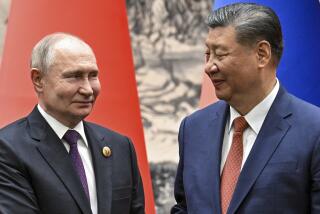Years of Friendship, Years of Stress
1921: Chinese Communist Party organized in Shanghai, with Mao Tse-tung one of founders. Soviet Communists, whose own revolution had triumphed four years earlier, offer support and advice through Comintern. Moscow also helps fledging Chinese Republic, based in south, headed by Sun Yat-sen. Under Soviet prodding, Communists and Sun’s Nationalists join in mid-20s in a united front against warlords. 1927: Chiang Kai-shek, Nationalist leader after death of Sun, turns against Chinese Communists. In surprise attacks in Shanghai, thousands of Communists are killed. United front ends, Chinese civil war begins. Communists undertake Long March in 1934 to escape Chiang’s forces; Communist faction that includes Mao and Chou En-lai wrests control of party from “28 Bolsheviks,” a Soviet-trained faction. 1949: Mao’s Communists triumph over Nationalists, who flee to Taiwan, and Mao proclaims the People’s Republic of China. Moscow quickly recognizes new government. Mao complains later that Soviets had pressured Chinese Communists to stop short of victory over Nationalists in Chinese civil war for fear of provoking U.S. intervention. During early 1950s, Moscow supplies loans, blueprints and technical assistance to help Chinese build up industry. 1959: Sino-Soviet relations deteriorate. Moscow objects to Beijing’s truculence in international affairs, reneges on giving Chinese technical data for nuclear weapons; Soviets disparage China’s abortive Great Leap Forward, and Nikita S. Khrushchev calls Mao’s people’s communes old-fashioned and reactionary. Mao suspects Moscow of meddling in Chinese Communist factionalism. In 1960, Moscow abruptly ends aid to China, withdraws all of the nearly 1,400 Soviet technicians and advisers from China, leaving about 200 major projects unfinished. Pullout disrupts China’s development, causing great losses but eventually forcing China to become more self-reliant. Ensuing Sino-Soviet split opens deep gap in world Communist movement. 1962: Chinese accuse Soviets of provoking incidents along their border in Central Asia, and of stirring resistance to Beijing’s rule among Muslim minorities. Moscow charges Chinese with violating Soviet frontier. Chinese in mid-60s press for settlement of boundary disputes dating from “unequal treaties” of czarist times, but talks collapse. Soviets build up military forces along frontier. Soviet and Chinese troops clash in 1969 along Manchurian border, killing dozens on each side. Summer brings more clashes in Xinjiang. Amid war fears in China, Soviet Premier Alexei Kosygin meets Chinese Premier Chou En-lai at Beijing airport their,tough talks leading to inconclusive border negotiations. 1972: After Chinese and U.S. diplomatic feelers, President Richard Nixon visits Beijing in 1972, launching Sino-U.S. reconciliation after years of hostility. Sino-U.S. detente reshapes triangular rivalry among Beijing, Moscow and Washington. China and the United States restore diplomatic relations in 1979, and Chinese leader Deng Xiaoping urges the United States, Western Europe and Japan to work together to contain the Soviet Union. 1979: Soviet backing for Vietnam’s invasion of Cambodia, and Moscow’s own intervention in Afghanistan, anger China, which adds these issues to existing Soviet military buildup along Chinese border to make “three obstacles” barring improved Sino-Soviet relations. 1985: The new Soviet leader Mikhail S. Gorbachev says that one of his top priorities will be to improve Sino-Soviet relations. Showing more flexibility than his predecessors, Gorbachev over next three years softens stance on border dispute, reduces Soviet forces on China’s border, withdraws Soviet troops from Afghanistan, after Moscow’s nine-year intervention there, and urges Vietnam to pull its troop out of Cambodia, where they have fought Chinese-backed rebels. The groundwork is laid for a Sino-Soviet summit in Beijing.
More to Read
Sign up for Essential California
The most important California stories and recommendations in your inbox every morning.
You may occasionally receive promotional content from the Los Angeles Times.










